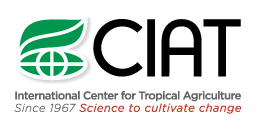Soil restoration in Ethiopia: Not so dirt cheap
Soil loss in Ethiopia is an expensive problem, adding up to more than US$100 million every year. The country is locked in a cycle of land degradation and poverty, costing it not just money, but soil and crop harvests as well.
“It may not mean much for a farmer that soil erosion in Ethiopia’s highlands reaches over 130 tons per hectare every year,” said Lulseged Tamene, CIAT soil scientist in Ethiopia. “Farmers understand better if they can see interventions in the landscape – what erosion means in terms of yield loss, what the major drivers are and how to solve them.”
To achieve this, researchers at CIAT and key partners, including CGIAR research centers ILRI, ICRAF and IWMI, and Mekelle University – involved in the Africa RISING project, which stands for the Africa Research in Sustainable Intensification for the Next Generation – have installed erosion plots and hydrological stations to monitor sedimentation and water yield at different scales and with different management practices.
How communities are reversing land degradation in Ethiopia’s expensive soil habits #GLFCOP21 https://t.co/xfmfjELjcS pic.twitter.com/Mkreo82I9J
— CIAT (@CIAT_) December 8, 2015
While farmers realized they were losing soil, they didn’t know how much, nor how to tackle it. At the same time, researchers had identified top drivers of soil loss, such as poor land management – for example, planting crops on steep slopes – combined with intense rainfall on bare sloped land.
CIAT is leading the Integrated Landscape Management component of the Africa RISING project, which involves collecting and analyzing soil data to advise communities about better land and water management practices, to protect the whole landscape.
Sustainable intensification, the team argued, can best be done through Integrated Natural Resources Management: tackling soil erosion at the whole landscape level – rather than at farm plot level – to transform dust bowls into healthier landscapes able to withstand climate shocks.
Intensification cannot be sustainable at plot or farm level, if the landscapes and watersheds continue to degrade. Research teams worked together with the local community to pin-point land degradation hotspots, and to identify options for how best to manage them.
To show farmers that land degradation is reversible if managed well, an exchange visit was arranged to Tigray Region, where watersheds have been transformed from almost “desert-like” conditions.
Tigray Region, Ethiopia






























Africa RISING the climate-smart way
The Chairman of Adisghe County, near Debre Birhan city, recorded the visit on his mobile phone and showed the footage to his community, inspiring them to transform their eroded landscape. “I knew that if we did one tenth of the work they did, we could bring our land back,” he said.
Through high-resolution satellite imagery, the community has helped researchers identify soil erosion hotspots. Together, researchers and farmers have mapped gulley erosion by looking at satellite images and walking and tracking coordinates, then digitally plotted on maps, and discussed to decide what actions to take.
#fromthefield looking at #soil and water conservation in action in #Ethiopia #IYS2015 @CIAT_ @WLE_CGIAR #africarising pic.twitter.com/380hhDVdlg
— Juliet Braslow (@JulietBraslow) May 28, 2015
Two years later, the proof is literally in the landscape. After hands-on training in the field, the community has built check dams, ditches and ponds, and water has percolated through to the lower part of the landscape. Trial data shows doubled yields in some areas following good agronomic practices and appropriate fertilizer application.
This not only improves the structure of the soil – it also improves the retention capacity of the landscape. Especially valuable during drought, more water is now available for farming and other income-earning activities.
Research is still ongoing to collect, analyze and map soil data to build a more complete picture. Challenges remain, among them the need for more communities to start using the approaches that have already worked.
Africa RISING’s coordinator Kindu Mekonnen, said: “We have introduced these new technologies, created good partnerships with communities and demonstrated how different technologies are useful. Now we need to take this to the wider scale – we’re in the process of working with partners to do that.”




